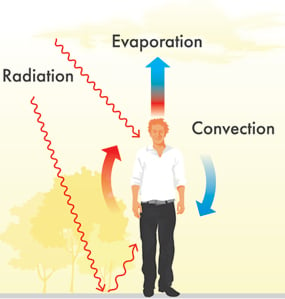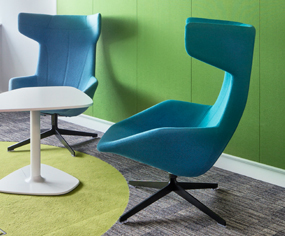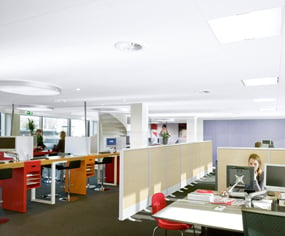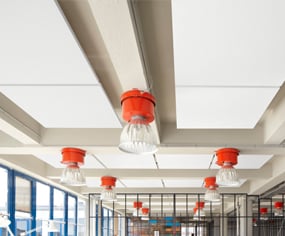Thermal comfort

Thermal comfort describes the human satisfactory perception of the thermal environment. It refers to a number of conditions in which the majority of people feel comfortable.
Thermal comfort is rated amongst the most important conditions for improving comfort and satisfaction of occupants with their indoor environment, based on a review of various studies1.
In most buildings, the ceiling is the least disrupted surface. It is free of objects or coverings. Floors, by contrast, are often covered by many objects (furniture, rugs, equipment). In terms of performance, the ceiling is preferable; it becomes a large thermal transfer surface, imbuing it with a more active role.
What affects thermal indoor environment?
 The heat exchange between the human body and its environment occurs mainly in three ways, namely through:
The heat exchange between the human body and its environment occurs mainly in three ways, namely through:
- radiation
- convection
- evaporation.
Thermal indoor environment is affected by both internal and external sources.
Common heat sources:
- electrical equipment (such as lighting and computers)
- sun radiation
- human presence
Common sources of cold:
- window surfaces
- poorly insulated walls
- thermal bridges in the constructions
All these sources will influence the human perception of the environment and therefore the comfort level.2

Thermal comfort refers to the percieved feeling on the human body as the result of
the effect of heat and cold sources in the environment.
Factors that influence thermal comfort
Thermal comfort is mainly influenced by six variable factors which are needed to maintain a healthy balance in order to sustain the occupants’ satisfaction with their surrounding environment.
Air temperature: a common component of thermal comfort; it can easily be influenced with passive and mechanical heating and cooling.
Mean radiant temperature: the weighted average temperature of all exposed surfaces in a room. Combined with the air temperature, it allows defining the operative temperature which is the most essential component of thermal comfort.
Air velocity: (or air flow) quantifies the speed and direction of the air movements in the room. Rapid air velocity fluctuations might result in draught complaints.
Humidity: (or relative humidity) is the moisture content of the air. Too high or too low humidity levels may induce discomfort.
Clothing level: the amount of insulation added to the human body. Higher clothing levels will reduce the heat lost through the skin and lower the environment´s temperature perceived as comfortable.
Physical activity level: (also called metabolic heat) has an influence on the amount of heat produced by the human body and therefore also in the perception of a hot or cold environment.
In practice, the factors influenced by the typology of ceilings in use are:
- Air temperature, as it could be influenced by how the ceiling allows the air to be cooled in contact with the slab in the case of TABS.
- Mean radiant temperature, as it could be influenced by the coverage ratio of radiant panels in the ceiling.
- Air velocity, as it could be affected by the disposition of absobers and the size of air gaps between panels, through which convection can occur
Average comfort rating
Combining all the factors mentioned above, an average comfort rating can be predicted3. However, in some cases it can be impossible to reach a thermal environment that satisfies all the occupants of a building because of their individual preferences.
In those cases, it's still possible to specify conditions that are likely to be perceived as acceptable to most4. And if combined with opportunities for individual control (such as change of clothing or window opening ), the overall satisfaction with the environment will increase considerably.
Thermal comfort affects the work performance
Thermal conditions can affect the building occupants’productivity and work performance through several mechanisms. Thermal discomfort can:
- cause attention distraction
- disturb well-being
- reduce the ability to concentrate properly5
Thermal comfort and acoustics
If a high quality indoor environment is strongly dependant on thermal comfort, it is crucial to think of it in combination with other indoor parameters, such as:
- acoustics
- lighting
- air quality
The importance of acoustics on occupants’ well-being is no longer to be proven. There are in fact combined effects:
Insufficient acoustics combined with poor thermal comfort will reinforce each other and rapidly lead to negative consequences on the end-users.

From an architectural point of view, thermal comfort is associated with soft materials and smooth surfaces such as textiles, porous surfaces or even wood. Flat and hard surfaces (made of metal or stone) are on the other hand perceived as less convenient for thermal comfort.
It's not yet scientifically described what triggers this perception, but one could assume that it relates to the perceived radiative exchange with a given surface. This is described through emissivity. Emissivity ranges from 0 to 1, where glossy, metallic surfaces show an emissivity close to 0, and matt surfaces are close to 1.
A fully‐covering sound‐absorbing ceiling will therefore contribute to both the thermal and the acoustic comfort of the building occupants. Depending on the type of temperature management system present in a building, Ecophon provides different product solutions applicable in each case to guarantee high indoor comfort levels.
Integrating HVAC systems with acoustic solutions
 In conventional buildings, acoustic ceilings are the interface between the building services and equipment (HVAC, lighting, etc.). They tend to cover 80 to 90% of the floor area, from wall to wall.
In conventional buildings, acoustic ceilings are the interface between the building services and equipment (HVAC, lighting, etc.). They tend to cover 80 to 90% of the floor area, from wall to wall.
E-tools like Drawing Aid propose a wide range of practical ways to integrate HVAC systems and acoustic solutions.
Under the last few years, one has seen an increase of hydronic heating and cooling systems based on lightweight radiant panels. If the ceiling is still entirely covered, the coverage ratio of sound absorbers is typically reduced to 40 to 70% of the ceiling surface in this case, as this latter also accommodates the radiant panels.
Wall absorbers are great complements to the ceiling surface in case the whole room surface is not available for high performance sound absorbers.
Thermally-Activated Building Systems
 In buildings with concrete core cooling, also called TABS (Thermally-Activated Building Systems), the ceiling cannot be fully covered for thermal transfer reasons, in order to allow the energy to transfer between the room and the concrete slab. Still, it can benefit from room acoustic optimization.
In buildings with concrete core cooling, also called TABS (Thermally-Activated Building Systems), the ceiling cannot be fully covered for thermal transfer reasons, in order to allow the energy to transfer between the room and the concrete slab. Still, it can benefit from room acoustic optimization.
Depending on the type of ventilation system, such buildings can be equipped with free hanging acoustic units or baffles to control the acoustic of the room, combined with wall absorbers. Studies show that high levels of thermal comfort are achievable with ceiling coverages up to 60% with free hanging sound absorbers in TABS buildings6.
In order to evaluate the impact of the horizontal absorbers on the operative room temperature, Ecophon has developed a specific Type for TRNSYS, one of the most used thermal simulation softwares. Please ask your Technical Design support for a copy.
For more information, download our knowledge guide (pdf)
References:
1. M. Frontczak, P. Wargocki, Literature survey on how different factors influence human comfort in indoor environments. Build. Environ. 46, pp. 922-937, 2011.
2. S.P. Corgnati, M. Gameiro da Silva, R. Ansaldi, E. Asadi, J.J. Costa, M. Filippi, J. Kaczmarczyk, A.K. Melikov, B.W. Olesen, Z. Popiolek, P. Wargocki, Indoor climate quality assessment – evaluation of indoor thermal and indoor air quality. Rehva Guidebook 14. Rehva, Brussels, 2011.
3. T. Witterseh, Environmental perception, SBS symptoms and the performance of office work under combined exposures to temperature, noise and air pollution, PhD Thesis, Technical University of Denmark, 2001
4. EN 15251:2007-08,Indoor environmental input parameters for design and assessment of energy performance of buildings addressing indoor air quality, thermal environment, lighting and acoustics. European Committee for Standardization, 2007.
5. J. Varjo, V. Hongisto, A. Haapakangas, H. Maula, H. Koskela, J. Hyönä, Simultaneous effects of irrelevant speech, temperature and ventilation rate on performance and satisfaction in open-plan offices. Journal of Environmental Psychology 44, pp. 16–33, 2015.
6. N. Rage, Experimental and theoretical study of the influence of acoustic panels on the heat exchange between Thermo-Active Building Systems (TABS), the occupants and the room. MSc thesis, Technical University of Denmark, 2015.

